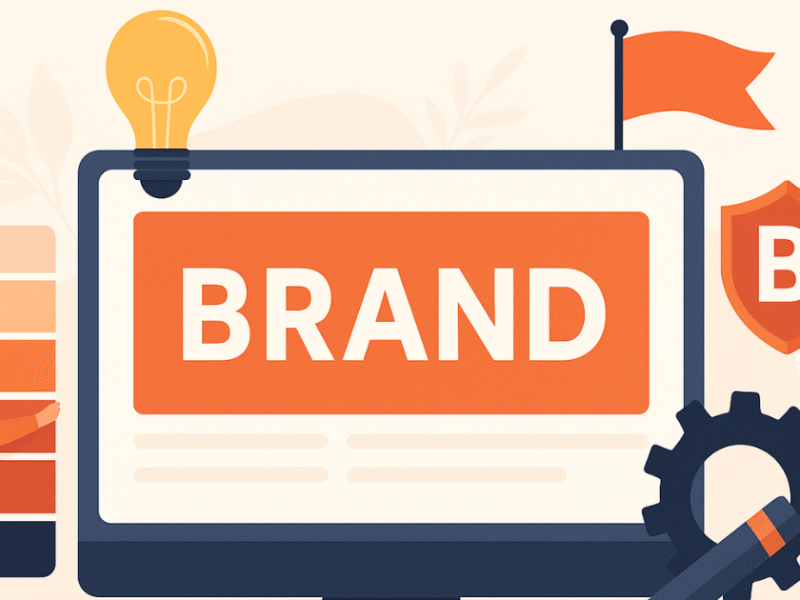When customers walk into one of your locations or land on a local store’s page they expect the same experience they had last time. That’s the power and promise of Brand Consistency. In a franchise model, however, turning that promise into daily reality is challenging. Different owners, teams, markets, and vendors create endless variation. Done right, you can scale without diluting what makes your brand special. Done poorly, you risk confusing customers, eroding trust, and losing lifetime value.
This guide gives you a complete, hands-on playbook to keep the brand intact as you grow: standards that are simple to follow, systems that make the right choice the easy choice, and a cadence of audits and coaching that elevate performance. You’ll see exactly how to set guardrails, empower franchisees, and measure impact so Brand Consistency becomes a true competitive advantage.
What you’ll get:
- A clear definition of Brand Consistency in a franchise context
- A “freedom within a framework” model that scales
- The essential standards every franchise needs visual, verbal, and experiential
- Tools and workflows that eliminate guesswork and rework
- Training and coaching programs that actually change behavior
- Governance, audits, and KPIs that drive continuous improvement
- A 90-day rollout plan to upgrade your locations fast
Let’s turn Brand Consistency into a system your teams can trust and your customers can feel.
What Brand Consistency Means in a Franchise Context
Brand Consistency is the alignment of what your brand looks like, sounds like, and feels like everywhere a customer encounters it. In a franchise network, it’s the glue that holds the experience together across cities, regions, and cultures.
- Visual: Logos, colors, typography, uniforms, signage, packaging, and store design
- Verbal: Tone of voice, messaging pillars, taglines, menu/product names, customer scripts
- Experiential: Greeting rituals, service standards, cleanliness, music, scent, speed, issue resolution
The aim is not sameness for its own sake. The aim is predictable quality with meaningful, high-impact local variation. Customers should recognize your brand instantly and know what to expect, while local teams adapt to local needs without crossing the lines that define who you are.
Two truths can coexist:
- Absolute uniformity is unrealistic and often counterproductive.
- Guardrails and shared playbooks are essential to protect Brand Consistency as you grow.
The Business Case: Why Uniformity Pays
Protecting Brand Consistency isn’t just an aesthetic choice it’s a strategic growth lever.
- Trust and recall: Repeating cues (sight, sound, service) cement memory and preference.
- Conversion and basket size: Predictable experiences reduce decision friction and increase add-ons.
- Customer lifetime value: Reliability strengthens loyalty and frequency.
- Unit economics: Consistent operations reduce waste, training time, and rework.
- Marketing efficiency: Brand-wide campaigns perform better when locations execute consistently.
- Valuation: Strong brands with reliable execution command higher multiples and attract better operators.
Treat Brand Consistency like an operating system: a core capability that compounds results over time.
Freedom Within a Framework: The Scalable Model
The most resilient way to scale is to define what is fixed, what can flex, and what should be local. This “freedom within a framework” approach keeps your core intact while encouraging market-relevant creativity.
| Layer | Definition | Examples | Governance |
| Non‑Negotiables | Elements that define the brand’s identity and cannot change | Master logo, core colors, primary typefaces, tone principles, mission, cleanliness standards, safety protocols | Central brand team owns; enforced in agreements |
| Regional Flex | Elements that may adapt within set parameters | Seasonal campaigns, secondary color ranges, region-specific imagery, pricing bands, promo calendars | Regional lead approves within documented rules |
| Localize | Elements franchisees tailor to their community | Store events, local partnerships, charity tie-ins, localized socials, hiring messaging | Local owner decides; brand team provides playbooks |
Document this structure in your standards manual and reinforce it in onboarding and coaching. This clarity prevents debates and protects Brand Consistency without stifling local entrepreneurship.
Build a Standards Playbook That Works in the Real World
A binder full of rules that no one reads won’t deliver. Your standards must be usable, visual, and integrated into daily workflows.
Visual Identity Standards
Logos and Clear Space
- Provide master files in vector and web formats
- Specify minimum sizes, safe zones, and placement rules
- Show correct and incorrect usage with side-by-side visuals
- Require approved lockups for co-branded executions
Color and Typography
- Define primary and secondary palettes with Pantone, CMYK, RGB, HEX values
- Include contrast guidance for accessibility
- Provide scale and pairing rules for headings, body, and numerals
- Offer pre-built styles in design tools to lock in choices
Photography and Illustration
- Define subject matter, lighting, composition, and diversity standards
- Provide a curated library with searchable tags
- Include a “do/don’t” gallery to prevent stock-photo drift
Callout: The easier it is to choose the right asset, the stronger your Brand Consistency will be.
Verbal Identity and Messaging
Voice and Tone
- State your brand personality in five adjectives
- Provide tone sliders (formal/informal, playful/serious) with examples
- Create message maps for core audiences and scenarios
Naming and Copy Standards
- Product/menu naming conventions and forbidden words
- Approved taglines and usage rules
- Copy length ranges for headlines, descriptions, and call-to-actions
Service Scripts and Microcopy
- Greeting, upsell, and issue-resolution scripts
- In-app or kiosk microcopy libraries for error states and confirmations
- Translate and localize with a glossary to preserve nuance
Experience Standards
Store Design and Sensory Cues
- Layout templates with flexible modules
- Approved materials and finishes for durability and brand feel
- Music and scent guidelines (tempo, genre, suppliers)
- Lighting zones and temperature standards
Uniforms and Personal Presentation
- Approved uniform sets by role and climate
- Grooming and name badge standards
- Seasonal options within defined palettes
Service Quality Benchmarks
- Time-to-greet, ticket times, cleanliness checks by zone
- Mystery shop scoring rubric
- Issue triage and recovery protocol with service recovery phrases
Experience is where Brand Consistency becomes tangible. Design standards around the “moments of truth” that matter most.
Systems That Make the Right Choice Easy
Standards are the blueprint; systems are the scaffolding. Build workflows and tools that nudge everyone toward the right behaviors every day.
Your Enablement Stack
- Digital Asset Management (DAM): One source of truth for approved logos, photos, video, and templates with version control
- Template Management: Lock brand elements but allow fields for local details; export press-ready files
- Content Management System (CMS): Components with guardrails so local pages can be built without breaking layout rules
- Product Information Management (PIM): Single source of product names, descriptions, and specs to prevent drift
- Local Listings and Reviews: Central tool to manage Google Business Profiles, hours, photos, and responses with guided templates
- Social Scheduling: Shared calendars with creative kits and approval gates
- Print and Signage Portal: Approved vendors, pre-spec’d materials, color profiles, and pricing
The more you centralize approved assets and pre-built templates, the more natural Brand Consistency becomes.
Governance and Approvals That Don’t Slow You Down
- Tiered approvals: Auto-approve low-risk edits; escalate when rules are broken
- SLA-backed support: Creative help desk with response times and a service catalog
- Co-op funds tied to compliance: Reimbursements require proof of standards adherence
- Immutable change logs: Track who changed what and when for audits
- Approved Vendor List (AVL): Signage, uniforms, printing, and fixtures with negotiated specs and color calibration
Lightweight oversight protects Brand Consistency while preserving local speed.
Training, Certification, and Culture
Standards are only useful if people know and believe in them. Invest in training that is short, practical, and repeated.
Onboarding That Sticks
- Pre-opening bootcamp: Brand story, standards tour, and hands-on exercises building a local flyer and location page
- Microlearning modules: 5–8 minute lessons on signage, social posting, upsell scripts, and review responses
- Play-and-apply: Every module ends with an action in the real store or online profile
Certification and Continuous Coaching
- Role-based certifications: Owner, manager, frontline, and marketer tracks
- Quarterly refreshers: Update on seasonal campaigns and new templates
- Brand coaches: Regional field managers who review execution, give feedback, and share best practices
Champion Programs
- Brand Champions: Recognize employees who model standards; give early access to campaign kits
- Peer forums: Monthly virtual meetups for owners to trade tactics
- Incentives: Bonuses or co-op multipliers tied to scorecard performance
Culture beats enforcement. When teams are proud to deliver, Brand Consistency follows.
Asset and Template Management in Practice
Templates are the bridge between standards and execution.
- Lock the essentials: Logo, colors, core layout, and disclosure text
- Open the fields that matter: Location, hours, local offer, event details, and phone
- Pre-flight checks: Automatic validations for logo size, contrast ratios, and image resolution
- Versioning: Archive retired templates; mark superseded assets to prevent reuse
This is where your DAM and template tools earn their keep by operationalizing Brand Consistency at scale.
Approvals, QA, and Pre‑Flight
Mistakes are expensive. A simple pre-flight checklist prevents costly reprints and off-brand posts.
Print and Signage Pre‑Flight
- Verify template version and material spec
- Confirm Pantone/CMYK values and color profiles
- Check bleed, trim, and resolution (300 DPI for print)
- Confirm legal copy and disclosures
- Route to an approved vendor with calibrated equipment
Digital Pre‑Flight
- Confirm page is using correct components and styles
- Validate copy against tone and naming conventions
- Check image alt text and contrast for accessibility
- Confirm tracking parameters and correct location links
A 10-minute check now can save thousands later and preserve Brand Consistency in the wild.
Local Marketing Without Dilution
Local marketing brings heart and relevance. Done within guardrails, it strengthens the brand.
Local Events and Partnerships
- Provide an event-in-a-box kit: banners, social posts, talking points, and follow-up emails
- Offer a partner checklist: alignment with values, co-branding rules, and approval steps
- Set photography guidelines for event recaps and user-generated content
Promotions and Offers
- Define a discount ceiling and prohibited tactics (e.g., no coupon stacking that harms value perception)
- Provide offer templates with swap-in fields and required legal text
- Tie co-op reimbursement to full compliance and results reporting
Local teams thrive when boundaries are clear; Brand Consistency holds even as ideas flourish.
In‑Store Experience: Where the Brand Lives
The store is the stage; your standards are the script.
- Planograms: Shelf layouts with photos, facings, and reorder points
- Daily rhythm: Open/close checklists, cleanliness sweeps, cue for music and scent
- Service moments: Greet within X seconds, offer Y, resolve issues with Z steps
- Accessibility: Clear signage, aisle width, and service accommodations
- Seasonal swaps: Pre-bundled kits with placement maps and teardown schedules
Operational discipline is the unsung hero of Brand Consistency.
Digital Presence: Many Locations, One Brand
Your digital footprint is often the first encounter. Align every location’s presence.
Location Pages
- Consistent URL structure and naming conventions
- Shared components: hero, hours, map, services, reviews, and CTA
- Local content block for unique highlights within word-count limits
Google Business Profiles and Listings
- Standardized business name, categories, and attributes
- Photo guidelines and schedules (exterior, interior, team)
- Review response templates with room for personalization
Social Media
- Shared content calendar with post templates and caption starters
- Guardrails for contests, giveaways, and UGC
- Crisis response playbook and escalation matrix
Digital discipline is a major driver of Brand Consistency across markets.
Governance, Legal, and Risk
Clarity and enforcement protect the brand and the network.
- Franchise agreements: Explicit references to the standards manual, update cadence, and cure periods
- Brand Council: Cross-functional group that reviews changes and approves regional flex requests
- Change management: Versioned standards, annotated updates, and side-by-side diffs
- Compliance program: Scheduled audits, friendly warnings, corrective plans, and, when necessary, sanctions
- Approved vendor contracts: Color proofs, material specs, SLAs, and penalties for out-of-spec production
Governance is the backbone that keeps Brand Consistency from becoming optional.
Measurement: The Brand Consistency Scorecard
What gets measured improves. Build a scorecard that blends customer outcomes and execution inputs.
Outcome Metrics
- Net Promoter Score (NPS) by location
- Repeat visit rate and subscription/loyalty enrollment
- Organic review ratings and volume
- Conversion rate (in-store and online for local pages)
Execution Metrics
- Mystery shop scores against service and visual standards
- Compliance rate for signage and promotions
- Listing accuracy (name, address, phone, hours)
- Social posting cadence and brand-safe adherence
Process Metrics
- Asset adoption rate (approved vs. custom)
- Time-to-launch for campaigns
- Training completion and certification pass rates
- Audit closure time for non-compliance issues
Create a composite Brand Consistency score out of 100 with weighted inputs. Share it transparently with owners. Celebrate top performers and coach the rest.
A 90‑Day Rollout Plan to Level Up Every Location
You can make serious progress in a single quarter with a focused plan.
Days 1–30 Foundation
- Audit: Sample 15% of locations for visual, verbal, and experiential gaps
- Standards refresh: Update your manual with “freedom within a framework”
- Kits: Publish core templates and a seasonal campaign-in-a-box
- Tools: Roll out your DAM and template system with short training
- Governance: Stand up the Brand Council and approval SLAs
Include a kickoff call with owners. Explain why Brand Consistency grows unit sales and protects local investments.
Days 31–60 Enable and Launch
- Training: Microlearning plus a 60-minute live workshop per region
- Pilots: Run the seasonal campaign with 10–20 test locations
- Feedback: Gather operator input; fix friction in templates and workflows
- Vendors: Finalize AVL; place first unified orders for signage/uniforms
Days 61–90 Measure and Scale
- Audits: Light-touch brand checks across 50% of locations
- Scorecard: Publish the initial composite scores; set quarterly targets
- Co-op: Tie reimbursements to compliance and performance proofs
- Recognition: Announce Brand Champions and share best-practice spotlights
By the end of 90 days, Brand Consistency should be visible in-store and online, with a system that keeps improving.
Budgeting and Co‑Op: Fueling the System
Money is strategy. Aim for a shared investment model that rewards good execution.
- National fund: Covers standards, creative kits, DAM, and major campaigns
- Co-op: Reimburses local spending that follows approved templates and vendors
- Matching: Extra matching for top performers on the scorecard
- Bulk buys: Centralize large orders (signage, uniforms) for scale and spec control
Align dollars with outcomes and Brand Consistency becomes everyone’s incentive.
Vendor Management and Production Quality
Your brand’s look lives or dies in production.
- Color management: Calibrated printers, Pantone libraries, contract proofs
- Material specs: Durable substrates, correct finishes, weather-rated outdoor materials
- Uniforms: Size ranges, fabric specs, and care guidance to keep colors and fits consistent
- Packaging: Die lines, ink limits, and sustainability claims that match reality
Use quarterly vendor reviews with sample audits. Consistent production equals consistent perception.
Crisis and Reputation Management
Issues happen. Clear protocols preserve trust and cohesion.
- Escalation tree: Who to call in which scenario service, safety, or social
- Holding statements: Pre-approved language for fast response
- Social guide: What to acknowledge, when to take offline, and how to apologize
- Post-mortem: Root-cause analysis and standards updates to prevent repeats
A cool head and prepared playbook protect Brand Consistency when it matters most.
Sustainability and Community Standards
Values show up in choices. Codify the ones that matter to your brand.
- Materials: Recycled content, supplier certifications, and end-of-life guidance
- Energy: Lighting specs and equipment maintenance for efficiency
- Community: Approved charity and school partnerships; volunteer kits
- Reporting: Simple trackers so locations can share wins and impact
Shared values strengthen identity and unify execution.
Pitfalls That Erode Consistency (and How to Avoid Them)
- Vague standards: Replace abstract rules with visual examples and exact specs
- Too many exceptions: Use the framework table to decide once and document
- DIY design: Provide templates; require approvals for custom work
- Rogue vendors: Enforce AVL; tie co-op funds to approved production
- Training as a one-off: Use microlearning and quarterly refreshers
- Hidden scorecards: Share results and recognize top performers
- Slow approvals: Tier risk and auto-approve low-risk changes
Remove friction and you’ll protect Brand Consistency without heavy policing.
Case Snapshots
- Quick-serve concept, 180 locations
- Problem: Inconsistent drive-thru menus and promos
- Fix: Template system with locked pricing zones and auto pre-flight
- Result: 96% on-time promo swaps; +7% average check during national promos
- Fitness brand, 75 studios
- Problem: Varied class naming and social tone
- Fix: Messaging guide with caption starters and class naming map
- Result: +18% social engagement; more accurate schedule discovery
- Home services franchise, 120 territories
- Problem: Listing inaccuracies and off-brand vehicles
- Fix: Central listings tool, vehicle wrap specs, and photo audits
- Result: 92% listing accuracy, +14% call volume from local search
These wins compound when the system is simple, supportive, and measured.
FAQs
What’s the fastest way to improve Brand Consistency across many locations?
Start with a seasonal campaign-in-a-box, a refreshed standards manual with clear visuals, and a template system that locks core elements. Pair it with short training and a light audit. You’ll see visible gains within a month.
How strict should we be to maintain Brand Consistency without stifling franchisees?
Draw a bright line between non-negotiables and local latitude. Enforce the former, empower the latter. Use tiered approvals and co-op incentives to keep speed and quality in balance.
What tools help most with Brand Consistency?
A reliable DAM, template management with locked brand elements, a listings/reviews platform, and a print portal with approved vendors. These remove guesswork and reduce errors.
How do we measure Brand Consistency objectively?
Create a composite score (out of 100) using mystery shop results, signage and promo compliance, listing accuracy, social adherence, training completion, and customer outcomes like NPS and review ratings.
How do we handle local ideas that don’t fit Brand Consistency?
Route them through the Brand Council. If an idea fits the “regional flex” rules, approve quickly. If not, adapt it to align with standards or test it in a limited pilot with clear success criteria.
What’s the role of the franchise agreement in Brand Consistency?
The agreement should reference the standards manual, require adherence, define update cadence, and outline cure periods. It provides the legal foundation for consistent execution.
How can small franchise systems achieve strong Brand Consistency with limited budgets?
Prioritize a clean standards manual, a lightweight DAM (even a structured drive to start), a few high-impact templates, and a monthly coaching call. Consistency is more about discipline than spend.
How do we keep Brand Consistency during rapid expansion?
Bake standards and tools into the new location checklist. Train before opening, certify after week one, and audit at 30 and 90 days. Centralize large orders for signage and uniforms to keep specs tight.
How should we adapt for different cultures without breaking Brand Consistency?
Localize imagery, copy examples, and events while protecting core values, visual identity, and service standards. Use the “freedom within a framework” model to guide decisions.
Conclusion: Make Consistency a Daily Habit
You don’t achieve Brand Consistency with a single memo. You achieve it by designing a system where the right choice is obvious, fast, and rewarding backed by clear standards, practical tools, steady training, and a fair scorecard. Start with your non-negotiables, give franchisees freedom within guardrails, and measure what matters. The result is a network that looks, sounds, and feels like one company earning trust, loyalty, and growth with every interaction.
Ready to put this into action? Assemble your standards refresh, publish your first campaign-in-a-box, turn on template approvals, and schedule a 30-location audit. In 90 days, your customers and your numbers will notice.








